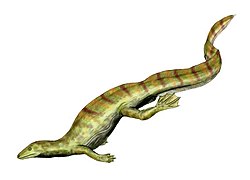Tangasaurid
| Tangasauridae Temporal range: Late Permian-Early Triassic, 253.8–249.7 Ma |
|
|---|---|
 |
|
| Hovasaurus. | |
| Scientific classification | |
| Kingdom: | Animalia |
| Phylum: | Chordata |
| Class: | Reptilia |
| Clade: | Neodiapsida |
| Family: |
†Tangasauridae Haughton, 1924 |
| Subgroups | |
Tangasauridae is a family of eosuchian diapsids. Specimens have been found that are of Late Permian to Early Triassic in age from the Sakamena Group of western Madagascar. They lived alongside other taxa present from the Sakamena Group, including temnospondyls, rhynchosaurs, and gomphodont eucynodonts. Fossils have been found of numerous specimens of common members of this family such as Hovasaurus and Thadeosaurus in different stages of ontogenic development. Recent material from the Middle Sakamena Formation of the Morondava Basin of Madagascar that dates back to the early Triassic period suggests that the Tangasauridae were relatively unaffected by the Permian-Triassic extinction event.
Tangasaurids are known to have been a highly derived group of diapsids. One subfamily, the Kenyasaurinae, is composed of taxa that were fully terrestrial. They had long toes and highly developed sternums that made them well suited to life on land. On the other hand, the other subfamily, the Tangasaurinae, composed of taxa that were adapted to an aquatic life. They had webbed feet and a laterally compressed tails that allowed them to be able to swim in the freshwater lacustrine environment present at the time. Because of their highly derived aquatic characteristics and occurrence in time, it has been suggested that the tangasaurids were a direct ancestor of the superorder Sauropterygia, which includes many highly derived marine aquatic reptiles such as placodonts, nothosaurs, and plesiosaurs.
...
Wikipedia
